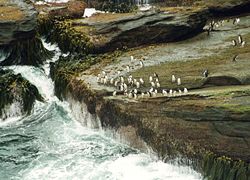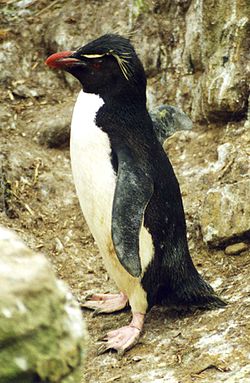New Island
| New Island | |

| |
|---|---|
| Location | |
| Location: | 51°43’18"S, 61°18’1"W |
| Area: | 8.8 square miles |
| Highest point: | 741 feet |
| Data | |
| Population: | uninhabited |
New Island is an uninhabited island of the Falkland Islands, lying north of Beaver Island.
Long used as a base for whaling, as a sheep farm and for occasional attempts to collect guano, New Island is considered by some to be one of the most beautiful islands in the Falklands archipelago, as well as well as having possibly the most diverse range of wildlife in the region. The whole island, 8.8 square miles of it, is a nature reserve, established by Ian Strange in 1972.
New Island lies 148 miles from Stanley and is 8 miles long with an average width of 820 yards. The highest point is 741 feet. The northern and eastern coasts have high cliffs but the eastern coasts are lower lying, with rocky shores and sandy bays. There are several smaller offshore islands. North Island and Saddle Island have high cliffs but Ship Island and Cliff Knob Island are lower lying. [1]
History
New Island was one of the earliest of the Falkland Islands to be colonised, and American whalers may have arrived as early as the 1770s. Two place names on or near the island, Coffin's Harbour and Coffin's Island, commemorate the Coffin family of Nantucket. Nearby Quaker, Barclay, Fox and Penn islands reflect the New England and Quaker provenance of some of the earliest settlers.
In 1813, Captain Charles H Barnard, from Nantucket, was marooned with his crew on the island.[2] They survived on the island for two years, and constructed a crude stone building, which is probably incorporated into the Barnard Building, the oldest standing building in the Falklands and now a museum restored in 2006.
In 1823, Antarctic explorer Captain James Weddell anchored at the island, and commented on its excellent harbours and its natural food and water supplies. In the 1850s and 60s, the island's guano deposits were mined. A settlement lies in the middle of the east coast of the island, some distance north of an airstrip.
The island holds the shipwreck of a sealing vessel, the Protector III, which beached in 1969.
New Island Conservation Trust
Since 1996 the island has been owned and run by The New Island Conservation Trust which acquired the freehold of the entire property in 2005. The Trust is managed by a Board of Trustees under the Chairmanship of Air Vice-Marshal David Crwys-Williams CB, a former Commander of the British Forces, Falklands Islands, in the 1980s.[3] The major benefactor to the Trust has been the Geoffrey C Hughes Charitable Trust which not only made the purchase possible, but also funded the well-equipped Field Centre used as a base for teams of wildlife researchers from many different countries. The Trust relies entirely on donations to continue its conservation and research work.


Wildlife
Wildlife includes fur seals, Southern Elephant Seals, South American Sea Lions, Slender-billed Prions, [Rockhopper, Gentoo and Magellanic Penguins, Dolphin Gulls, Black-browed Albatrosses, Falkland Skuas and Upland Geese.
There are no native land mammals since the now extinct Falkland Islands Wolf, or Warrah, was exterminated there, though the island contains a population of introduced cottontail rabbits (Sylvilagus sp.).[4]
The islands vegetation is mainly grasses; there are no trees, though shrubs have been introduced.
References
- Stonehouse, B (ed.) Encyclopedia of Antarctica and the Southern Oceans (2002, ISBN 0 471 9866 58)
- ↑ Falklands Conservation; PART II: Falkland Islands Important Bird Areas - New Island Group. The source uses metric units.
- ↑ New Island history
- ↑ David Crwys-Williams
- ↑ Falklands Wildlife
Outside links
| ("Wikimedia Commons" has material about New Island) |